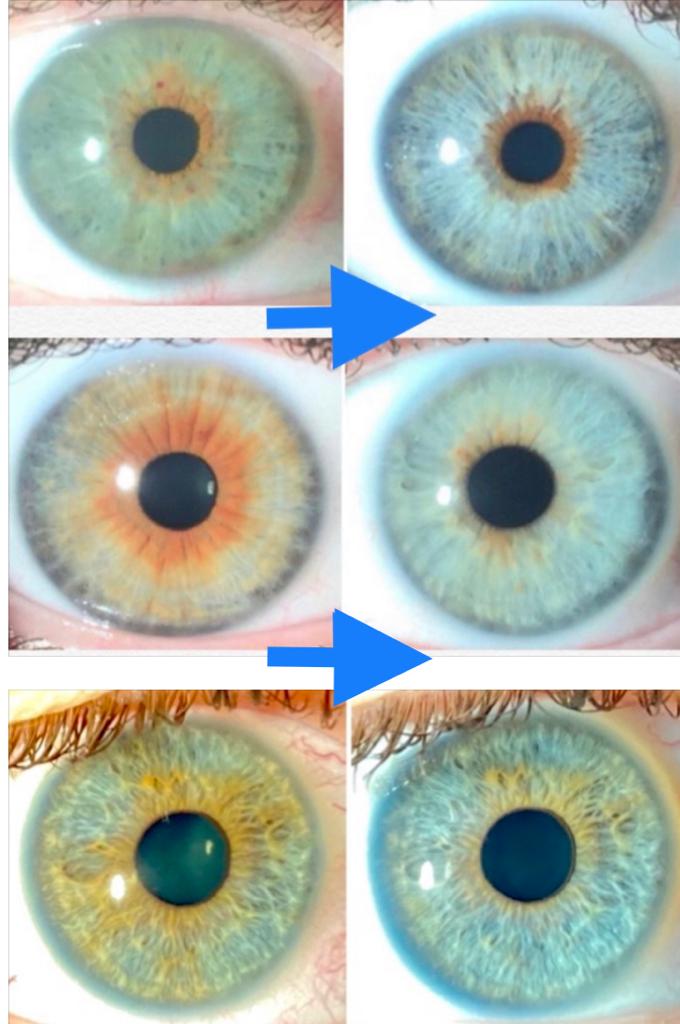In today’s day and age, there does exist the ability to choose your eye color in the same way that you choose your outfit for the day: with the use of colored contact lenses.
However, the daily insertion, removal, cleaning, and maintenance of contacts can be thought of as a hassle, which is why people are looking for long-term fixes.
Some people also consider the use of contacts as an artificial manipulation of one’s eye color, pushing them to go for surgery in order to make the change a permanent part of their appearance.
In this article, we’ll look at the four methods that are currently available to change the color of your eyes, both temporary and permanent, and discuss the pros and cons of each.
What Determines the Color of Our Eyes?
In order to understand the ways in which eye color can be changed, we need to know what gives our eyes their natural color.
When we discuss eye color, we are actually referring to the hue of the portion of the eye called the “iris.”.
The iris is a sheet-like structure present inside the eye, behind your cornea, and in front of your lens. It changes its size in response to light, becoming larger in dark lighting and smaller in bright lighting. This way, it controls the amount of light entering your eyes.

The color of the iris is determined by the amount of a brown pigment called melanin. This is the same pigment that gives color to our skin and hair.
The various natural shades of eye color are a result of the different densities of melanin present in the iris and the scattering of light from the intricate and unique structure of each person’s iris.
Although eye color is inherited from parents to their biological offspring, its inheritance is complex as it involves a number of different genes. These genes will not only determine the amount of melanin in your eyes but also the amount and arrangement of collagen fibers inside them, both of which will affect your natural eye color.
Because melanin is the only colored pigment present in the iris, natural human eye colors are different hues of one of these six colors: brown, hazel, blue, green, gray, and amber.
Non-surgical Options for Eye Color Change
There is only one non-surgical option available to change the color of your eyes, which is contact lenses.
There are a multitude of color options available that allow you to change the color of your eyes to whatever shade you wish, whenever you like.
Compared to the surgical options for eye color change, they are also the safest when used properly.
It’s important to use colored contact lenses—or any contact lenses, for that matter—according to your eye doctor’s instructions.
For safe use of contact lenses, some important rules to follow are:
- Wash your hands before handling them.
- Clean and store them properly.
- Inspect them for damage before inserting them.
- Avoid sleeping in them.
- Avoid showering or swimming in them.
- Replace them according to the manufacturer’s instructions.
- Get fitted for them by an eye doctor.
- Buy only from reputable brands.
Colored contacts can be bought in stores or online, but make sure to get fitted by a qualified eye doctor to prevent any eye problems. The FDA (Food and Drug Administration) classifies all contact lenses as medical devices, which means you need a valid prescription to buy them.
Moreover, use contacts from a reputable brand that uses high-quality materials and design to ensure comfort and safety.
Remember that while contact lenses are the safest option for eye color change, their use is not without risk. Improper use of contact lenses can lead to serious eye infections that cause permanent damage to vision. Always consult your eye doctor for proper guidance on the handling, use, and fitting of contact lenses.
Surgical Options for Eye Color Change
There are currently three surgical options available for eye color change. Each of these changes the color of your eyes permanently. They work by either adding or extracting color from your eyes.
Iris Implant Surgery

Cosmetic iris implant surgery is a dangerous procedure that is used to permanently change the color of the eyes.
In this surgery, a little cut is made in the cornea on the front of the eye, through which a colored silicone implant is inserted and placed over your natural iris to give your eyes a new color.
Using Iris implants for cosmetic purposes is not approved in the United States by the FDA, which means performing this surgery is illegal. Patients usually travel to other countries to get this procedure done.
The American Academy of Ophthalmology, which is the authority that speaks for all eye doctors, has also issued a warning against the dangers of this surgery. It is now considered malpractice amongst the eye surgeon community to perform cosmetic iris implant surgery.
Cosmetic iris implants very commonly cause a number of serious problems, such as glaucoma, cataracts, chronic inflammation, infection, and permanent damage to the cornea and natural iris.
Following the development of complications, the implants need to be removed through another surgery. Unfortunately, taking out the implant does not undo the damage.
Multiple hospital visits, long-term medications, and further complex surgeries are required to control the damage from the complications.
Even with further surgeries, full recovery of vision might not be possible, and eyes are even left permanently disfigured and blinded from the complications.
Cosmetic iris implant surgery should be absolutely avoided by anyone considering cosmetic eye color change surgery.

Right (A) and left (B) eyes of a patient who was implanted with blue cosmetic artificial iris implants. Despite cosmetic iris removal, there was permanent corneal and iris damage and the development of cataracts in both eyes (C, D).
Ghaffari, R., Aldave, A. J., Al-Hashimi, S., & Miller, K. M. (2021). Complications of Cosmetic Artificial Iris Implantation and Post-Explantation Outcomes. American Journal of Ophthalmology, 226, 156–164.
Artificial iris implants are not just used for cosmetic purposes. They are also used in people who have damaged or absent iris from trauma, eye diseases, or congenital conditions.The implants used for such conditions are FDA-approved and have a very low rate of complications. However, they cannot be used by people with normal irises. This is because the implant is designed to be placed ‘behind’ the damaged iris, unlike cosmetic implants that are placed in front of the iris.
Corneal Tattooing
It doesn’t change the color of the iris but instead adds color to the cornea to conceal the natural color of the iris.
In order to improve the appearance of such eyes, doctors can inject medical-grade ink into the cornea, resulting in a permanent change of eye color.
Certain eye surgeons are now offering corneal tattooing as a cosmetic procedure for individuals seeking a permanent transformation of their eye color.
Corneal tattooing for cosmetic purposes is done with the help of a laser. This is the same laser utilized in Lasik surgery.
The surgeons who perform this surgery claim it to be safe as it does not involve surgery on the inside of the eye and therefore does not carry all the risks that are seen with iris implant surgery. However, there are a number of other concerns that need to be considered.
It also makes the doctor unable to examine the inner layers of your cornea, the angles of your eyes, your true field of vision, and the entire extent of the back of your eye. Additionally, it prevents the eye doctor from being able to perform surgery for cataracts, glaucoma, and corneal and retinal issues.
The results of the procedure are also thought to look artificial, with a fixed pupil, giving a doll’s eye appearance.
Reaction to the dye can cause inflammation inside the eye or corneal neovascularization (the formation of new abnormal blood vessels in the cornea).
That being said, corneal tattooing seems to be a relatively safer choice for people seeking to permanently change their eye color, but it is not without its own set of complications.
Better research with long-term follow-up is needed to determine the effects it might have on the eye.
The cost of keratopigmentation can vary with the provider and type of equipment used, but it starts at roughly $10,000 for both eyes.
Scleral tattooing
This is a highly unsafe and risky procedure that has not been medically or scientifically studied and is not performed by eye doctors.
Unfortunately, this trend has caused numerous complications that eye doctors have had to address.
Many cases have been reported where the needle and dye were accidentally injected all the way into the eyeball. As a result, these individuals experienced severe eye pain, damage to the lens and retina, permanent loss of vision, and sometimes even had to undergo the removal of the eye.
Laser depigmentation for cosmetic changes in eye color is a new technique that involves the removal of pigment from the iris.
For changing the eye color, the laser settings are changed, and it is applied to the front part of the iris to remove melanin pigment from the surface of the iris. This causes a lightening of the color of the eye.
Software is used to predict the eye color that you will have after the procedure.

Supporters of this technique consider it to be the safest way of changing eye color, as the eye remains practically untouched.
The released pigment can cause inflammation inside the eye, causing redness, pain, and blurring of vision.
Thinning and lightening of the iris tissue can lead to increased light sensitivity.
Laser depigmentation for cosmetic eye color change is a new technique that has not been actively researched and followed up long-term for potential complications.
Laser depigmentation costs somewhat less than other eye color change procedures because it doesn’t involve any cutting of tissues. Prices can vary greatly by provider, ranging from $5,000 to $7,000 or more for both eyes.
Conclusion
We have deliberately excluded implant surgery from the conclusion due to the dangers associated with it, which is why it should not even be considered.
The research already done on these techniques is by centers that are performing the surgery, so their impartiality is questionable.

